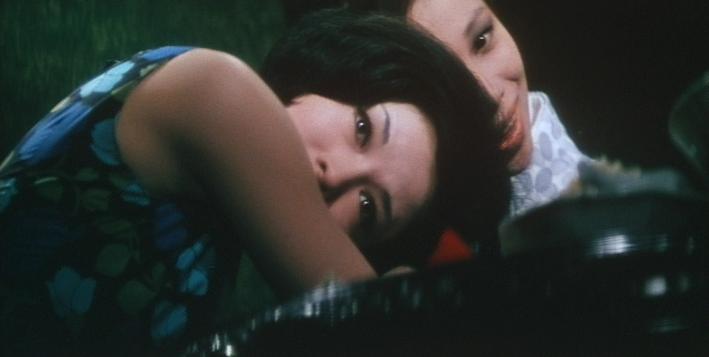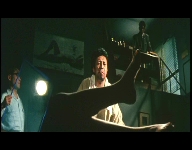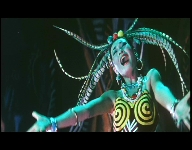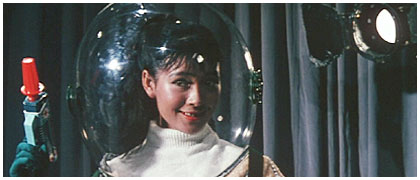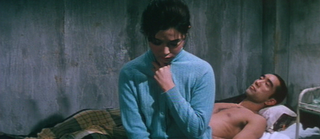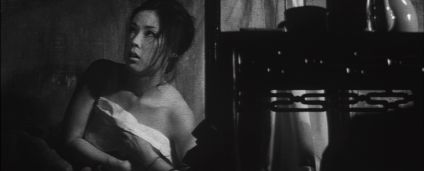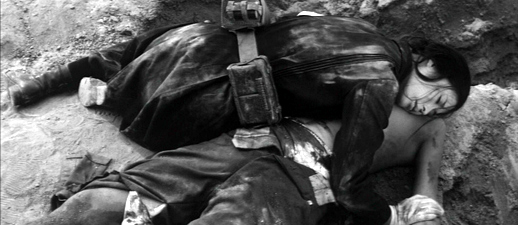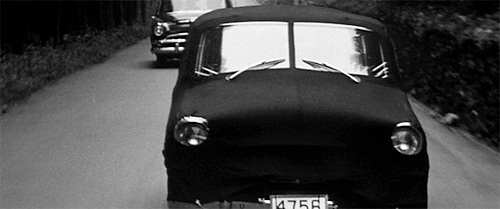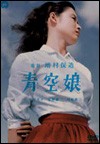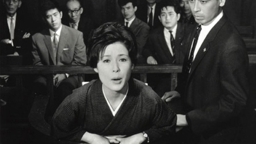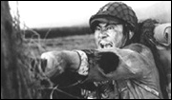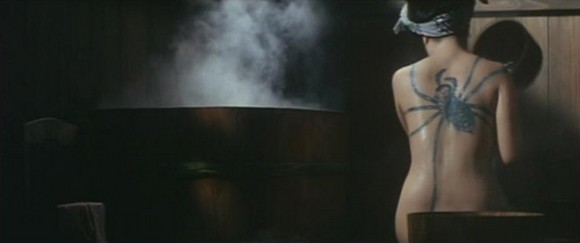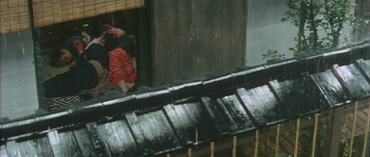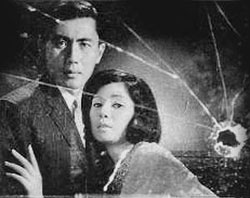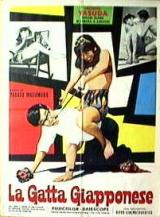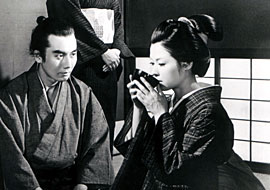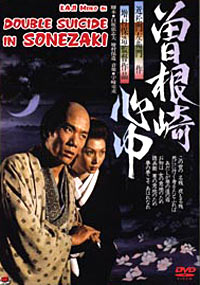This was written for Film Comment in 2002, but only the first part was published in their September-October issue that year, under the title “Enlightened Madness”. This was designed to be accompanied by a sidebar highlighting ten of Masumura’s films, but the editor, Gavin Smith, after proposing the sidebar and thereby getting me to revise the first piece accordingly, subsequently decided to place the sidebar only on the magazine’s website, thereby sabotaging my plan for the two pieces to work together, as a two-part unit, and reducing much of the sidebar, as a stand-alone unit, to gibberish.
Much of both parts got recycled years later in an essay included in Movie Mutations, a collection I coedited with Adrian Martin. — J.R.
To appropriate one of the categories of Andrew Sarris’s The American Cinema, Yasuzo Masumura (1924-1986) is a “subject for further research.” Considering that he made 58 films between 1957 and 1982, none of which has ever had a normal commercial run in this country, that may even be putting it mildly. But so far I’ve managed to see 38, all but one over the past four years, and though the range in quality is enormous, I’d swear by at least half of them. Six are now being released on DVD by Fantoma —- four out already, with excellent supplementary materials about Masumura and the films themselves, and two more on the way —- and they provide a welcome introduction to a fascinating and singular figure.
Masumura’s cinema is a cinema of fanatics, and I’ve become something of a fanatic myself in tracking his oeuvre. The first film of his I saw, the 1967 Love of an Idiot, was playing under the title La chatte japonaise when I saw it in Paris in the early 70s. But I didn’t get going in earnest until I caught another seven in a traveling retrospective organized by Kyoko Hirano that came to Chicago in 1998. Then, with the inestimable help of Chika Kinoshita, a Chicago-based Mizoguchi scholar — who lent me videos, helped me acquire others, and provided me with scene-by-scene synopses of most of them so that I could watch them unsubtitled, meanwhile translating various portions of his collected writings for me (some of which are quoted below) — I saw another nine. During a visit to Japan hosted by the Japan Foundation, I was able to see eight features with an interpreter at Tokyo’s National Film Center, and three years later — after having tracked down various others on video -— I saw nine at Berkeley’s Pacific Film Archives. And at the same time I was pursuing this obsession, I was gratified to see him becoming a significant cult figure in both Japan and Europe. In Japan alone, three books devoted to Masumura have appeared since 1998 and a full retrospective played in Tokyo last year, followed by the release of many more titles on video and DVD. (Prior to this renaissance, the three worst Masumura films I’ve seen, all late works and spinoffs of other films, were ironically among the most widely available on video: the dreadful Tortures of Hell/The Snare [1973], in the Edo-period “Hanzo the Blade” series, featuring a police detective who uses his iron-hard penis, hammered into shape by an anvil, as an instrument to torture women suspects; Turf Wars [1973], in the “Bad Reputation” yakuza series; and The Garden of Eden [1980], his only overseas film, an Italian spinoff of The Blue Lagoon.)
The man’s training was exceptional: after graduating from Tokyo University with a thesis on Kierkegaard in 1949, Masumura won a scholarship at the Centro Spirimentale Cinematografico in Rome, where Antonioni, Fellini, and Visconti were among his teachers. (The first of these is still a fan today, having only recently attended a Masumura retrospective in Rome.) After graduating, he assisted on an Italian-Japanese Madame Butterfly, then returned to Japan in 1954, where he worked as an assistant to Mizoguchi on Princess Yang Kwei Fei and Street of Shame at Tokyo’s Daiei studio. After Mizoguchi died, he went on to assist Kon Ichikawa on Punishment Room, Nihonbashi, and A Full-Up Train before directing his own first feature. (His spiky essay about Ichikawa can be found in James Quandt’s invaluable recent collection about the director.) Until Daiei went bankrupt in 1971, he became a house fixture at the studio, often making three or four features a year; then, for his remaining 11 years of directing, he averaged about one annually –an uneven output including at least two creditable achievements, Lullaby of the Earth (1976), one of his few independent productions, and Double Suicide in Sonezaki (1978), an adaptation of a Bunraku play by Monzaemon Chikamatsu. He also wrote extensively for Japanese TV — mostly, it appears, after he left Daiei — but my knowledge of this work is minimal.
What initially caught my interest was the uncanny way many of Masumura’s non-period films seemed to approximate many of the stylistic and thematic tropes of Samuel Fuller, Nicholas Ray, Douglas Sirk, and Frank Tashlin, without any evidence that he was influenced by any of them. (There are occasionally other echoes of Hollywood features, though always with significant differences: the gangster hero of the 1970 Ode to the Yakuza is incestuously driven by murderous sexual jealousy involving his sister, like Howard Hawks’s title hero in Scarface, but he eventually winds up sacrificing his life to ensure her happiness —- a very Japanese solution that wouldn’t occur to Tony Camonte.)
It’s paradoxical that Masumura should have been such a company man at Dahei, because his main theme is the pursuit of individuality to the point of madness —- a notion inspired in part by his years in Italy. As Canadian critic Mark Peranson puts it, “[Masumura’s] movies are about the freedom to do whatever the fuck you want, and the ramifications of taking this attitude when society won’t accept it.” This often gets played out in various groupings of features that might be loosely categorized as antiwar films, anticapitalist films, kinky sex films, youth films, and films with strong heroines — although, as with Fuller’s seemingly separate preoccupations with war, journalism, and crime, these categories often wind up interfacing to the point where they become indistinguishable.
A case in point is the delirious Sex Check (1968), which encompasses all five categories. To sketch out only the first 40 minutes, a dissolute former track star (Ken Ogata) fanatically trains and coaches an 18-year-old girl (Michiyo Yasuda) who works for an electrical company to become an Olympics athlete, meanwhile ditching the woman he lives with and ignoring every other female athlete on the company’s team. The ambitious company, yearning for the prestige of an Olympics champion, reluctantly agrees to his single-minded approach, which includes giving her frequent personal rubdowns. Having been advised years ago that athletes have to become beasts to get ahead, he tested this theory during World War 2 —- as we see in a brief flashback — by going berserk with his bayonet on enemy soldiers and raping lots of women, and he tries to introduce the same wisdom to his protégé. At their first meal together, he hands her a razor and says, “Shave every day so you can become a man; you have to overcome the limitations of female athletes,” and before long they’re also living together and having sex. (Later on, the question of whether she’s a hermaphrodite gets raised, complicating this psychosexual scenario considerably.)
A critic whose published writing, collected in 1999, is almost as plentiful as Jean-Luc Godard’s, Masumura theorized his position early on in a position paper replying to critics who charged him with making bleak and tasteless films with comically exaggerated and implausible characters, lacking sentiment and any depiction of environment or atmosphere. Boasting that he was guilty as charged on all these counts, Masumura offered the following rebuttals: (a) “Sentiment in Japanese films means restraint, harmony, resignation, sorrow, defeat, and escape,” not “dynamic vitality, conflicts, struggle, pleasure, victory, and pursuit….I buy the straight-forward and crude expression because I believe the Japanese restrain our desire so much that we tend to lose sight of our true mind.” (b) “There is no such a thing as non-restricted desire. A person who thoroughly reveals his or her desire can only be considered mad….[And] what I would like to create is not a stable person who cleverly calculates reality, and safely expresses his or her desire within the calculation. I don’t want to create a humane human being. I want to create a mad person who expresses his or her desire without shame, regardless of what people think.” (c) “What interests me is a conflict between expressions of naked desires which can’t be mitigated by the environment.”
In Masumura’s films, to cite my two favorites among the Fantoma releases, this madness can veer all the way from the hysterical promotional campaigns of three competing candy companies in the Tashlinesque Giants and Toys (1958) to an army nurse during the Sino-Japanese war in the hysterical and somewhat Fuller-like Red Angel (1966), an angel of empathy dispensing sexual favors to amputees and a drug-addicted doctor. It’s also the madness of war in Nakano Spy School (1966), where the personal and sexual betrayals of espionage ultimately rule out even patriotic alibis. One finds it in the dark madhouse conclusion of A False Student (1960), where a slow-witted, illegally-enrolled college student, after being kidnapped by Marxist radicals who think he’s a police plant, finally gets released only to be incarcerated in an insane asylum, where he mouths Marxist slogans. (This conclusion could have come straight out of Fuller’s Shock Corridor, if the latter hadn’t been made three years afterwards). And to cite three more of the Fantoma releases, it’s detectable in the obsessive industrial espionage between two car companies in Black Test Car (1962, forthcoming), the man and woman who are both so smitten by a sexy flirt in Manji (1964, see below) —- a close adaptation of Junichiro Tanizaki’s novel Quicksand — that they agree to a suicide pact she concocts, and the kidnapped model who willingly submits for “artistic” reasons to getting carved up by a blind sculptor in a warehouse in the 1969 Blind Beast.
As the last three examples and some others (including Sex Check and Giants and Toys) suggest, some of the madness is shared rather than strictly individual, pointing to a trait that Masumura seemed to identify as peculiarly Japanese. Furthermore, Giants differs from Tashlin in the deliberate ugliness of the garish colors and the misanthropic treatment of the characters. The film’s focus on a poor girl with spectacularly bad teeth being made the mascot of one candy company, then a media sensation thanks to the efforts of a photographer for a porn magazine, aims for a kind of unpleasantness that would have been minimized by Tashlin, who tended to enjoy many of the cultural and capitalist excesses he satirized.
Masumura argued that typical social problem films, including those of Italian neorealism, foster resignation by giving environment a deterministic force. But while insisting that he didn’t regard European society as superior to Japanese society, he maintained that “you can actually experience `beautiful and powerful man'” in Europe: “Their museums are filled with paintings and sculptures embodying the human beauty and power which the Europeans have spent 2000 years discovering and creating; their streets are crowded with people whose daring looks, confident steps, and lively demeanors convey their pride and confidence as Man. In Europe, `man’ is real.”
Critic Tadao Sato, who commissioned this 1958 article — and who takes credit for having discovered Masumura as a director — told me that Masumura was the first member of his generation to view such masters as Mizoguchi, Ozu, and Kurosawa with a certain amount of irreverence. A radical whose strategy was to bore from within, working with whatever came to hand (including existing genres, scripts, and actors), Masumura can’t generally be identified with a single visual style, although parallels to Douglas Sirk’s lighting and pastel colors are visible in the class critiques of his second and third features (The Blue Sky Maiden and Warm Current, 1957). “Some believe more in the image, others believe in the story,” he avowed in one interview. “Personally I believe in the story. Because images aren’t absolute, one can’t express everything with them.”
Though he sometimes criticized his actors, Masumura can be credited with steering Ayako Wakao, one of the most sensual of all Japanese film actresses, through many remarkable performances in at least 20 of his films — and most of his masterpieces. A Mizoguchi discovery, she’s the “blue sky maiden,” the title nurse in Red Angel, the sexy flirt in Manji, and the heroines in both A False Student and Tattoo. She also turns up in Afraid to Die (1960), the weakest of the Fantoma releases (though not without interest), where she gets slapped around repeatedly by the famous writer Yukio Mishima —- a former classmate and acquaintance of Masumura — in his first film role.
A movie that was chiefly made in order to gratify Mishima’s desire to star in one and show off his biceps and leather jacket, Afraid to Die became a major point of contention for Nagisa Oshima, who initially wrote about Masumura as a major beacon in 1958, before he embarked on his own features. But offended by the relative mediocrity of this yakuza thriller, Oshima withdrew his support, and apparently has never recanted. (In his highly subjective 1994 documentary 100 Years of Japanese Cinema, Masumura gets accorded one still, from his first film, Kisses — though considering that Mizoguchi, Ozu, and Kurosawa get only one clip apiece, this may be less dismissive than it sounds.)
Perhaps such a falling out was inevitable given Masumura’s profile in Japan as a western-influenced studio director, though this doesn’t account for how transgressive much of Masumura’s work still looks today from an American perspective. For me, what raises his best work far beyond simple exploitation is a complex ethical inquiry, combined with a rigorous refusal of sentimentality and a nuanced eroticism —- at times too essentialist to be feminist (as in Sex Check), yet still offering serious commentary on a society in which female sexuality has often served as coin of the realm. The way women’s “fortunes” get saved, spent, or squandered within this economy remains a profound ethical issue, and few directors apart from Masumura, his partial mentor Mizoguchi, and his partial disciple Oshima have made as many erotic films in tandem with the frankness of their political concerns.
A young couple in Kisses meet while visiting their fathers in prison; his is serving a term for an election day violation, hers for stealing money to pay her mother’s hospital bills. Not wanting her mother to know that her husband’s in jail, the girl is considering prostitution to raise the money for her father’s bail so that he can go visit his wife in the hospital. The heroine in Red Angel, a war nurse who’s raped, subsequently prostitutes herself for a pint of blood that might save the life of her rapist, insisting that she doesn’t want him to die because he might think she’s taking revenge.
This twisted, harrowing feature provides an ideal introduction to Masumura’s vision, so it’s a pity Fantoma is bringing it out last, apparently because it’s in black and white. By contrast, the gaudy Blind Beast is closer to inventive exploitation than to inquiry. I prefer the intricately witty, Tanizaki-derived analysis of sexual and romantic desire (both lesbian and straight) in Manji, and the ruthless unpacking of corporate greed and competition in both Giants and Toys and Black Test Car. Fantoma is firmly in our debt for finally making this agent provocateur visible; let’s hope that many more examples of Masumura’s enlightened madness are forthcoming.
Among the Missing: 10 Key Masumura Features
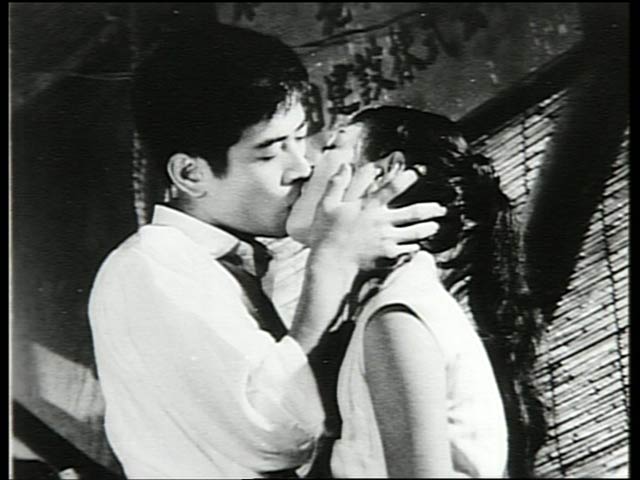
Kisses (1957, b/w): Masumura’s debut feature —- a touching teenage romance between a baker’s delivery boy and an artist’s model, mainly set over a one-day outing to the beach and races, has some of the flavor of Nicholas Ray’s youthful love stories. Later on, in features like Sex Check, the director would suggest much nuttier Ray pictures like Bigger Than Life, though this one, a commercial flop, reportedly seemed strange to Japanese audiences due to the speed and intonation of the dialogue delivery.
***
The Blue Sky Maiden (1957, color): Masumura’s second feature is his most Sirkian. An illegitimate country girl (Ayako Wakao) comes to Tokyo to find her mother, a cleaning lady, and encounters mainly her spoiled step-siblings and her businessman father —- whom she winds up denouncing in his sickbed and getting him to admit his errors, in a scene that must have shocked Japanese audiences at the time.
***
A False Student (1960, b/w ‘Scope): A well-made melodrama about radical Marxist college students kidnapping a mentally challenged boy on campus who’s pretending to be a student. This has one of Wakao’s most luminous performances, beautiful noirish cinematography, taut direction, and a critique of student paranoia that provides a fascinating cross-reference with Godard’s La chinoise.
***
A Wife Confesses (1961, b/w, ‘Scope): Probably Masumura’s greatest film —- a beautifully filmed courtroom drama told in flashbacks with a striking existential theme: fastened by rope to both her husband and her lover during a mountain-climbing accident, the heroine (Wakao) had to cut one loose to prevent all three from falling to their deaths, and opted for her abusive husband. Does that make her a murderer? Clearly influenced by Hiroshima, mon amour, which was partly made at the same studio, this is a no less serious tale about serious passion, and its story powerfully addresses the fatally interactive nature of Japanese society.

***
Yakuza Soldier (1965, b/w): All the violence in this raucous satire about army life during World War 2 is directed by Japanese soldiers against one another, so that when the two goofy heroes desert at the end, they’re treated as figures of exemplary sanity. This was a big enough hit to launch a sequel, and, as in Red Angel, there are some intriguing parallels with Altman’s M*A*S*H.
***
Tattoo (1966, color, ‘Scope) The second of Masumura’s three Tanizaki adaptations — preceded by Manji and followed by Love of an Idiot (see below) — this is based on two of his stories, “Tattoo” and “The Murder of Otsuya,” neither of which I’ve been able to find in translation. Wakao plays Otsuya, the daughter of a wealthy pawnbroker in the late Tokugawa period who runs off with his foreman, gets kidnapped and tattooed (with a female spider on her back), and is turned into a geisha who tempts men towards their doom. Masumura perversely objected to Kazuo Miyagawa’s striking cinematography with its beautiful diptych compositions by claiming that they detracted from the story.
***
Nakano Spy School (1966, b/w, ‘Scope): As in Masumura’s industrial espionage pictures, everyone winds up betraying everyone else because the system itself is intrinsically rotten. The narrator-hero graduates from officer training school during the China-Japan war of 1937, tells his fiancée to wait a couple of years until his discharge, and then never sees her again until he learns that she’s spying for the British and gets orders to kill her. Needless to say, they make love first.
***
Love of an Idiot (1967, color, ‘Scope): An updated adaptation of Tanizaki’s 1924 novel Naomi about a middle-aged factory engineer who trains, marries, and ultimately loses a teenage bride after she turns him into a slave to her whims. The intensity of his desire makes him a prototypical Masumura lunatic, and the creepy, quasi-abstract industrial landscapes evoke those of Antonioni —- though similar shots are found in Masumura’s 1959 Overflow, so any direct influence from Red Desert seems unlikely.
***
The Wife of Seishu Hanaoka (1967, b/w): An intriguing contrast to Preston Sturges’ The Great Moment by virtue of offering more challenges to the squeamish, this is an Edo-period biopic about Seishu Hanaoka, the first Japanese doctor to operate with general anaesthesia, with Wakao as his wife and Hideko Takamine as his mother —- both of them so devoted as rivals for his affection that they volunteer as guinea pigs for his experiments.
***
Lullaby of the Earth (1976, color): Choosing a late-period Masumura isn’t easy; for me it’s a toss-up between this ambitious tale of a fierce teenage girl from a mountain village in the 30s who becomes a prostitute and Double Suicide in Sonezaki [see above] two years later. In both cases, it’s a return to origins, i.e. Mizoguchi. If the latter film uses the same play as The Crucified Lovers, this one comprises Masumura’s own version of Life of Oharu.
— Jonathan Rosenbaum





